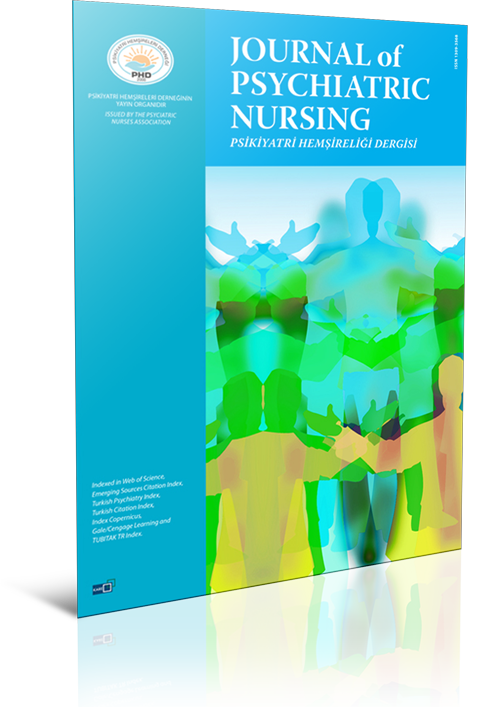
How do you prefer to be addressed?: The relationship between forms of address in nurse-patient communication and nursing care
Buket Şimşek Arslan, Ahmet Göktaş, Kadriye BuldukoğluDepartment of Psychiatric Nursing, Akdeniz University Faculty of Nursing, Antalya, TurkeyINTRODUCTION: The aim of this study is to examine the relationship between the forms of address used between nurses and patients and their effect on nursing care in Turkish culture.
METHODS: This descriptive study was completed with 186 inpatients at Akdeniz University Hospital in Antalya, Turkey. A personal information form and two scales concerning nursing care were used. The personal information form asked which forms of address the patients used with nurses. The data were analyzed using descriptive statistics, normality tests, the chi-square test and the Mann-Whitney U test.
RESULTS: The mean age of the patients was 50.9±16.5, and 50% were female. The study found that 54.9% of the patients were hospitalized for chronic disease, and 39.8% has been in treatment for 2-5 days. The formal form of address was used most by both nurses (59.1%) and patients (69.4%). Two-thirds of the patients (66.1%) preferred to be addressed informally by nurses. There were statistically significant differences between forms of address and age, education, marital status, number of children and occupation. There were statistically significant relationships between the Scale of Patient Perception of Hospital Experience with Nursing, the Nursing Care Behaviors Inventory-24 and forms of address (p<0.05).
DISCUSSION AND CONCLUSION: The formal form of addresses is usually used in communication between patients and nurses. However, most patients want nurses to address them informally. As patients age increases, nurses use of informal address also increases. The study also determined that the patients who were addressed informally were more satisfied with their nursing care.
"Size nasıl hitap edilmesini istersiniz?": Hemşire-hasta iletişiminde kullanılan hitap şekli ve hemşirelik bakımı arasındaki ilişki
Buket Şimşek Arslan, Ahmet Göktaş, Kadriye BuldukoğluAkdeniz Üniversitesi Hemşirelik Fakültesi, Psikiyatri Hemşireliği Anabilim Dalı, AntalyaGİRİŞ ve AMAÇ: Bu çalışmanın amacı, Türk kültüründe hemşire hasta iletişiminde kullanılan hitap şekli ve bu hitap şekli ile hemşirelik bakımı arasındaki ilişkiyi incelemektir.
YÖNTEM ve GEREÇLER: Tanımlayıcı türde olan çalışma, Akdeniz Üniversitesi Hastanesinde yatmakta olan 186 bireyle tamamlanmıştır. Veri toplama aracı olarak, Kişisel Bilgi Formu ve hemşirelik bakımını değerlendiren iki ölçek kullanılmıştır. Veri analizinde tanımlayıcı istatistikler, normallik testi, Pearson korelasyon testi ve Mann-Whitney U testi kullanılmıştır.
BULGULAR: Çalışmaya katılan hastaların yaş ortalaması 50.9±16.5 ve %50si kadındır. Hastaların %54.9unun kronik bir hastalık nedeniyle yatmakta olduğu ve %39.8inin tedavi alma sürelerinin 2-5 gün arasında olduğu saptanmıştır. Hemşireler hastalara (%59.1) ve hastalar hemşirelere (%69.4) çoğunlukla formal hitap şeklini kullanmaktadır. Hastaların üçte ikisi (%66.1) hemşirelerden kendilerine informal hitap şeklini kullanmalarını istemektedir. Hasta-hemşire arasındaki hitap şekline ilişkin değişkenler ile yaş, eğitim durumu, medeni durum, çocuk sayısı ve meslek arasında istatistiksel açıdan anlamlı fark bulunmuştur (p<.05). Hastanın Hemşirelik Bakımını Algılayış Ölçeği ve Bakım Davranışları Ölçeği-24 toplam puanı ile hemşire hasta arasındaki hitap şekli arasında istatistiksel olarak anlamlı ilişki bulunmuştur (p<.05).
TARTIŞMA ve SONUÇ: Hemşire-hasta iletişiminde genellikle formal hitap biçimi kullanılmaktadır. Fakat hastaların çoğu hemşirelerin kendisine informal hitap etmesini istemektedir. Hastanın yaşı arttıkça hemşirelerin hastalara karşı informal hitap şeklini kullanma durumları artmaktadır. Ayrıca informal hitap edilen hastalar, hemşirelik bakımından daha memnundur.
Manuscript Language: Turkish


















